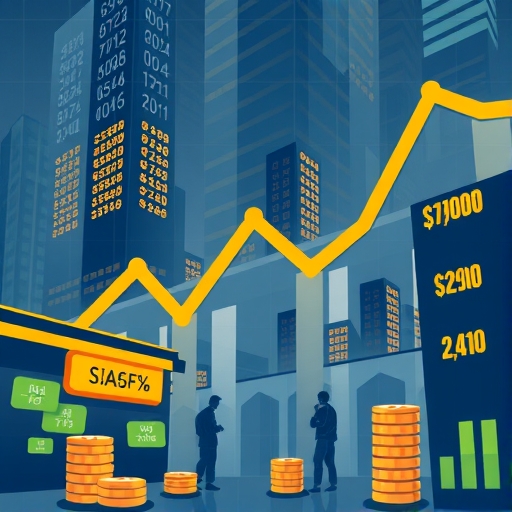Navigating 2025’s Global Markets: Why Diversifying with ETFs is Key
Are you looking to understand the shifting landscape of global investments in 2025? The year has presented a surprising start for the US stock market, with key indices experiencing significant declines amidst trade tensions and policy uncertainties. However, this period of domestic volatility has simultaneously highlighted robust growth and attractive opportunities in international markets, particularly in Europe, China, and various emerging economies. In this article, we’ll explore the factors driving these divergent performances and offer insights into how global **Exchange Traded Funds (ETFs)**, including innovative **AI-powered ETFs**, provide a strategic pathway for investors seeking diversification and sustained growth beyond traditional US-centric portfolios. We’ll break down market trends, highlight specific ETF categories, and discuss how you can leverage these tools for a more resilient investment strategy.

The US Market’s Unexpected Downturn in Early 2025
The early months of 2025 delivered an unexpected jolt to the **US stock market**. After reaching early January highs, the **S&P 500**, a widely followed benchmark for large US companies, experienced a significant downturn, falling almost 8.5% year-to-date by April 2025. This wasn’t just a minor dip; it represented a substantial erosion of investor confidence and market value, wiping out trillions. What caused this sudden shift? We can point to several key drivers that converged to create this challenging environment.
Primary among these drivers were **rising trade tensions** and **policy uncertainty**, particularly surrounding new tariffs. Following the November 2024 election, an initial rally fueled by optimism for deregulation and potential tax cuts quickly faded in early 2025. Donald Trump’s administration imposed new tariffs, including a 10% duty on all imports and a higher 34% tariff on certain Chinese goods. This move led to swift retaliatory measures from China, igniting fears of a full-blown trade war. Investors became increasingly worried about the impact on corporate profits, supply chains, and overall economic growth, leading to a sharp sell-off. Coupled with persistent **inflation worries**, these factors created a volatile and unpredictable atmosphere for US equities, underscoring the need for **global diversification** to mitigate such domestic risks.

International Markets: A Beacon of Resilience and Growth
While the US market grappled with its challenges, a different story unfolded across the globe. International markets, particularly in Europe and China, demonstrated remarkable resilience and impressive growth from late 2024 into early 2025, significantly outperforming their US counterparts. This divergence highlights the dynamic nature of the global economy and the importance of looking beyond your home market for **investment opportunities**.
**Europe**, for instance, showed a strong recovery, driven by targeted economic stimulus, a period of greater political stability, and a robust bounce-back in key sectors like manufacturing, technology, and energy. The **iShares MSCI Eurozone (EZU) ETF**, which tracks major companies in the Eurozone, was up over 16.4% year-to-date by April 2025. This impressive performance indicates a healthy economic environment and strong investor sentiment in the region. Similarly, **China** demonstrated significant resilience and growth. Supported by proactive government policies, including monetary easing and fiscal measures, as well as a strategic shift towards stronger regional trade within Asia, the Chinese market thrived. The **iShares China Large-Cap (FXI) ETF** saw an increase of over 13% year-to-date by April 2025, with technology, green energy, and consumer goods sectors leading the charge.
To illustrate the contrasting performances across key global markets by April 2025, consider the following summary:
| Market/Region | Key Index/ETF | Performance (YTD April 2025) | Contributing Factors |
|---|---|---|---|
| United States | S&P 500 | -8.5% | Trade tensions, policy uncertainty, inflation worries. |
| Eurozone | iShares MSCI Eurozone (EZU) | +16.4% | Economic stimulus, political stability, sector recovery (manufacturing, tech, energy). |
| China | iShares China Large-Cap (FXI) | +13% | Proactive government policies, regional trade shifts, growth in tech, green energy, consumer goods. |
These figures underscore the importance of international exposure in mitigating domestic market risks and capturing growth opportunities globally.
Beyond these major economies, a diverse array of **Emerging Markets** also delivered compelling returns. Countries such as Mexico, Chile, South Africa, Poland, Spain, and Greece have shown impressive growth since late 2024. These nations benefited from favorable domestic policies, ongoing economic recovery, and, crucially, less direct exposure to the volatility stemming from US-China trade tensions. Specific ETFs like **EPOL** (Poland), **EWP** (Spain), **ECH** (Chile), and **GREK** (Greece) exhibited strong 3-month returns, showcasing the broad-based nature of this international outperformance. These examples underscore that a truly diversified portfolio should consider these vibrant, growing economies that may move independently of the US market.

Exploring Specialized ETFs: Beyond Traditional Holdings
In today’s fast-evolving financial landscape, **Exchange Traded Funds (ETFs)** offer more than just broad market exposure; they provide targeted access to specific sectors, themes, and even advanced investment strategies. For investors seeking to capitalize on cutting-edge trends and enhance **portfolio diversification**, specialized ETFs, particularly **AI-powered ETFs** and **Cryptocurrency ETFs**, are becoming increasingly significant.
AI-Powered ETFs: The Future of Intelligent Investing
Imagine an investment fund that doesn’t rely on human portfolio managers but instead uses sophisticated computer programs to make buy and sell decisions. This is the essence of **AI-powered ETFs**. These innovative funds leverage **Artificial Intelligence (AI)** algorithms to analyze vast amounts of data – from traditional market trends and financial statements to alternative data sources like social media sentiment and news articles. By processing this information at speeds and scales impossible for humans, AI algorithms can identify patterns and make predictive judgments that aim to optimize returns and manage risk.
What are the benefits of these intelligent funds?
- Enhanced Performance: AI algorithms can quickly adapt to changing market conditions, potentially leading to superior returns. For example, the **Xtrackers Artificial Intelligence & Big Data UCITS ETF (XAIX)** returned an impressive 58.9% in 2023, showcasing the power of this approach.
- Dynamic Risk Management: AI can identify and react to emerging risks faster than human analysis, adjusting portfolio allocations to protect against downturns.
- Broader Diversification: By uncovering non-obvious correlations and opportunities, AI can help build a more truly diversified portfolio.
- Lower Fees: Often, AI-managed funds can operate with lower management fees compared to traditional actively managed funds, as the decision-making process is automated.
However, it’s also important to acknowledge the challenges. The complexity of these algorithms means understanding their inner workings can be difficult. The regulatory landscape around AI in finance is still evolving, and in truly unprecedented market events, their predictability could be tested. Despite these considerations, AI-powered ETFs like **AIQ** (Global X Artificial Intelligence & Technology ETF) and **UBOT** (Direxion Robotics, Artificial Intelligence & Automation Index Bull 2X Daily Leveraged ETF) represent a transformative force in passive investing, offering a glimpse into the future of capital allocation.
Cryptocurrency ETFs: Mainstream Access to Digital Assets
The world of digital assets, once considered niche, has firmly entered the mainstream through **Cryptocurrency ETFs**. These funds allow investors to gain exposure to digital currencies like Bitcoin and Ethereum without the complexities of directly owning, storing, or securing the underlying assets. The advent of spot Bitcoin ETFs in particular marked a significant milestone, attracting substantial institutional and retail interest.
Consider these key **Cryptocurrency ETFs** that have gained traction:
- IBIT (BlackRock iShares Bitcoin Trust): This spot Bitcoin ETF has seen remarkable asset inflows, quickly becoming one of the fastest ETFs to reach significant Assets Under Management (AUM).
- ETHA (VanEck Ethereum Strategy ETF): As Ethereum continues to grow in importance, ETFs focused on this second-largest cryptocurrency offer a way to participate in its ecosystem.
- BTGD (Range Global Bitcoin & Gold ETF): This unique fund offers equal exposure to both Bitcoin and Gold, catering to investors who value both digital and traditional “safe-haven” assets.
- CBOJ (AllianzIM Bitcoin Covered Call ETF): For those seeking Bitcoin exposure with a degree of risk mitigation, this type of structured ETF aims to provide downside protection through covered call strategies.
Understanding the different types of Cryptocurrency ETFs can help investors align their exposure with their risk appetite and investment goals. Here’s a summary of common types:
| Crypto ETF Type | Primary Exposure | Typical Investment Goal |
|---|---|---|
| Spot Bitcoin ETF | Direct exposure to Bitcoin’s price movements. | Gain straightforward access to Bitcoin without managing private keys. |
| Futures-Based Ethereum ETF | Exposure to Ethereum via futures contracts. | Participate in Ethereum’s ecosystem and price appreciation. |
| Hybrid Crypto/Commodity ETF | A mix of digital assets (e.g., Bitcoin) and traditional commodities (e.g., Gold). | Diversify with both new and traditional “store of value” assets. |
| Covered Call Crypto ETF | Bitcoin exposure with an options overlay strategy. | Generate income and potentially reduce volatility through covered calls. |
These funds are not without their volatility, reflecting the inherent price swings of cryptocurrencies. However, they provide a regulated and accessible avenue for investors to tap into the growth potential of the digital asset space, making them a noteworthy component of a diversified portfolio in 2025.
Other Sector-Specific ETFs to Watch
| Category | Description | Example ETFs |
|---|---|---|
| Growth & Tech | Focus on companies with high growth potential, often in technology. | QQQ (Nasdaq-100), VUG (US Large-Cap Growth), MAGS (Magnificent Seven) |
| Fixed Income | For those seeking stability or income, especially with evolving interest rate policies. | BOND (Active Bond), TLT (20+ Year Treasury Bond), SGOV (0-3 Month Treasury Bond) |
| Semiconductors | Critical for AI, computing, and electronics. | SMH (VanEck Semiconductor ETF) |
| Clean Energy | Investments in renewable energy sources and related technologies. | ICLN (iShares Global Clean Energy ETF), TAN (Invesco Solar ETF) |
| Financials | Banks, insurance companies, and other financial institutions. | XLF (Financial Select Sector SPDR Fund) |
| Homebuilders | Exposure to the residential construction sector. | XHB (SPDR S&P Homebuilders ETF) |
| Gaming & eSports | Targeting the rapidly growing entertainment and competitive gaming industry. | ESPO (VanEck Video Gaming and eSports ETF) |
These diverse options highlight how ETFs can be tailored to specific investment theses, allowing you to fine-tune your portfolio based on your outlook for different economic sectors and technological advancements.
Building a Diversified Portfolio with Global ETFs
Given the volatility observed in the **US stock market** in early 2025 and the strong performance of **international markets**, the message is clear: **global diversification** is not just a good idea, it’s a crucial strategy for building a resilient investment portfolio. Relying solely on one market, even one as large as the US, exposes you to concentrated risks that can be mitigated by spreading your investments across different geographies and asset classes.
So, how can you effectively build a globally diversified portfolio using ETFs?
- Understand Your Goals: First, assess your risk tolerance and investment objectives. Are you seeking growth, income, or a blend of both?
- Look Beyond US Borders: Actively seek out ETFs that provide exposure to Europe, China, and **Emerging Markets**. For example, instead of just investing in the **S&P 500** via **VOO** (Vanguard S&P 500 ETF), consider adding:
- EZU (iShares MSCI Eurozone ETF) for European exposure.
- FXI (iShares China Large-Cap ETF) or **MCHI (iShares MSCI China ETF)** for China.
- Country-specific ETFs like **EPOL** (Poland) or **EWW** (Mexico) for targeted emerging market exposure.
- Broad international ETFs like **IWDA (iShares Core MSCI World UCITS ETF)** for global developed market exposure excluding the US.
- Consider Equal-Weighting: If you’re concerned about the heavy concentration of a few “Magnificent Seven” tech stocks in market-cap weighted indices, an **S&P 500 Equal Weight ETF (RSP)** can offer a different form of diversification by giving equal importance to all companies in the index.
- Integrate Specialized Categories: As we discussed, incorporate **AI-powered ETFs** and **Cryptocurrency ETFs** to tap into high-growth, innovative sectors that offer different risk-reward profiles.
- Utilize Investment Platforms: Modern investment platforms have made accessing **US-listed ETFs** and global markets easier than ever. Many platforms offer features like low transaction fees, zero subscription or withdrawal charges, and even AI-recommended stocks or fractional investing, which can help you build a diversified portfolio efficiently. These platforms democratize access to a vast array of global **ETFs**, empowering you to construct a portfolio tailored to your unique needs without excessive costs or complexities.
To summarize, effective diversification hinges on several key principles that investors should always keep in mind:
- Minimizing concentration risk by avoiding over-reliance on a single market or asset class.
- Leveraging different economic cycles and growth drivers found in various global regions.
- Utilizing specialized funds to gain exposure to innovative sectors that may not correlate strongly with traditional market movements.
- Regularly reviewing and rebalancing your portfolio to maintain your desired asset allocation and risk profile.
By thoughtfully combining these strategies, you can construct a portfolio that is better positioned to weather regional downturns and capture growth wherever it occurs across the global economy. Diversification isn’t about avoiding all risk; it’s about managing it intelligently by spreading your bets.

Conclusion
The financial landscape of 2025 has underscored a critical lesson for investors: the importance of **global diversification**. While the **US stock market** experienced unexpected volatility driven by **trade tensions** and policy shifts, **international markets** in Europe, China, and various **Emerging Markets** demonstrated remarkable resilience and growth. These divergent **market performances** highlight that relying solely on one region can expose investors to unnecessary risks.
By strategically incorporating a mix of global **Exchange Traded Funds (ETFs)**, including innovative **AI-powered ETFs** and **Cryptocurrency ETFs**, you can build a more robust and adaptable portfolio. These funds provide accessible avenues to tap into diverse **investment opportunities** worldwide, from the economic recovery in Europe to the tech-driven growth in China and the advancements in artificial intelligence. Embracing a global perspective, facilitated by modern investment platforms, is key to mitigating regional risks and positioning your portfolio for long-term success in an ever-evolving global financial landscape.
Disclaimer: Investing in securities markets involves risks, including the potential loss of principal. This article is for informational and educational purposes only and does not constitute financial advice. Always consult with a qualified financial advisor before making any investment decisions.
Frequently Asked Questions (FAQ)
Q: What caused the significant downturn in the US stock market in early 2025?
A: The significant downturn in the US stock market in early 2025 was primarily attributed to rising trade tensions, particularly new tariffs imposed by the US administration, leading to retaliatory measures from China and widespread fears of a full-blown trade war impacting corporate profits and economic growth.
Q: How did international markets like Europe and China perform compared to the US market?
A: While the US market declined, international markets in Europe and China demonstrated remarkable resilience and impressive growth. Europe saw a strong recovery driven by stimulus and stability, and China thrived due to proactive government policies and regional trade, both significantly outperforming the US market.
Q: What are AI-powered ETFs and how do they benefit investors?
A: AI-powered ETFs are innovative funds that use Artificial Intelligence algorithms to analyze vast data and make investment decisions, aiming to optimize returns and manage risk. They can offer enhanced performance, dynamic risk management, broader diversification, and potentially lower fees compared to traditionally managed funds.



No responses yet